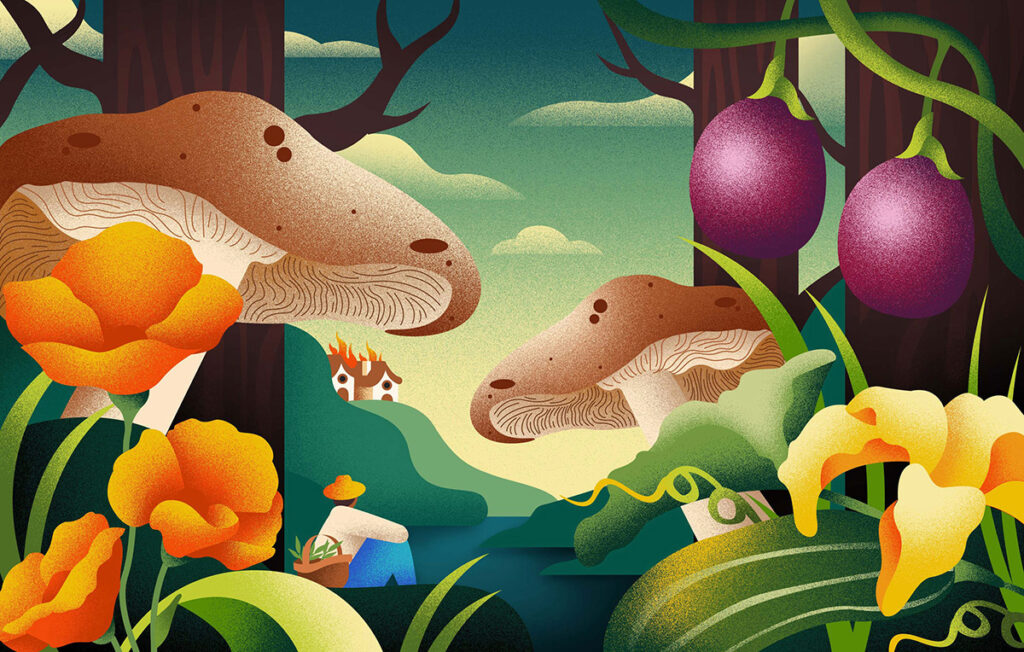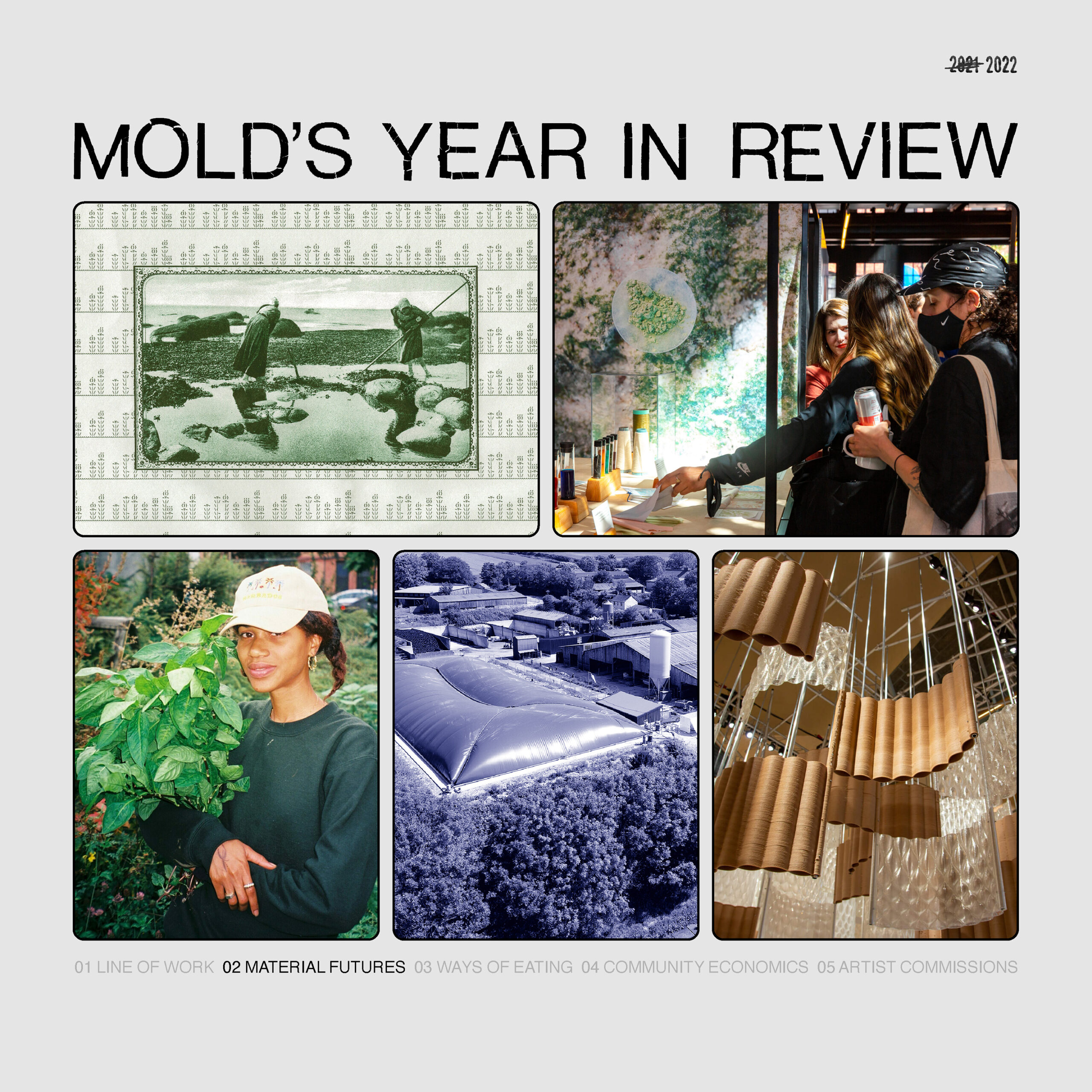This year, MOLD published pieces on topics that ranged from food and abolition to Octavia Butler’s legacy of worldbuilding. None of these would have been complete without artwork from our small community of artists, illustrators and designers. From Sarah Mafféïs’s playful survival kits, which recast the enduring question: “What’s in my bag?” to fit Lily Consuelo-Saporta Tagiuri’s prescient food forecasts, to Shawna X’s otherworldly, psychedelic portals, this year we’ve collaborated with artists whose work has helped to illustrate a vision of what the future of food and design might look like. As we reflect on the year, we’re highlighting some of our favorite features from the following editorial initiatives: Earthseed, Food and Abolition, Queering Theory, Food Forecast, and Relational Architectures.
A special bonus: If you’re curious, like I often am, to see the creative process behind these illustrations, I recommend you head to MOLD Magazine’s are.na page. There, you’ll find channels like this one by Joey Han, that reveal the generative iterations between artists and MOLD’s artistic director Kristi Huynh that lead to the final image. – MOLD Magazine Editors
Artwork by Jordan Moss
With Octavia Butler’s Parable of the Sower beginning on July 20, 2024, we capped off the summer season with Earthseed, a series that examines Parable of the Sower’s legacy in shaping our current attitudes toward food futures. We collaborated with Brooklyn-based illustrator Jordan Moss, to explore the story arc of the main character, Lauren Olmena. In Jordan’s illustrations you’ll find safe havens full of vibrant and fantastical vegetation, with hints toward disaster, looming in the far distance. In the first installment of Earthseed, we included California poppies (the Parable series takes place in California), purple passionflower, shiitake mushrooms and squash. Throughout the series, we continue to highlight location-specific plants and sprinkle in visual easter eggs to shed light on recurring themes in Parable of the Sower. Look closely and you’ll find references to themes like the prevalence of fire, which signifies destruction and death in the book.

Artwork by Joey Han
Food and Abolition is a series that considers how the political, social, and economic project of prison abolition can inform the movement for redesigning more sovereign food systems. For the third piece of Food and Abolition, we republished a conversation between Aisha Shillingford and jackie sumell from MOLD’s final print issue, Design for a New Earth. The piece features a newly commissioned illustration from NYC-based artist and designer Joey Han to highlight jackie summell’s philosophy: “Plants can help us become the people we need to be to dismantle the cruel and brutal prison system, end cycles of harm and ‘imagine a landscape’ without prisons.”

Artwork by Lisa Carpagnano
Queering Theory untangles critical theory through the multifarious lens of queer theory, food, and ecology. In this series, we collaborated with French illustrator, Lisa Carpagnano. In Queering Conventional Conservation, our lede illustration examines the dangers of binary thinking and conservation rooted in dualism, which Barney Pau describes as “conservation [that] discourages diversification, disregards non-normative ecologies, and displaces populations.” We set the scene up with Glacier National Park, home to dozens of melting glaciers, split into a diptych—with the left side depicting the landscape before ‘baseline,’ and the right side after ‘baseline.’ ‘Baseline’ is defined as “often when humans arrived, or, more accurately, when white Europeans arrived” and is justified by ‘Discovery Doctrine,’ or “an early-modern notion that places newly encountered by Europeans were thus uninhabited, irrespective of Indigenous presence, and fair-game to claim.”

Artwork by Sarah Mafféïs
Food Forecast is an ongoing series exploring the edible plants that will be available in increasingly extreme environments and an exploration of creative strategies to incorporate these plants into our everyday lives. For this series, we worked with French illustrator, Sarah Mafféïs, to create “survival kits.” Each survival toolkit includes 5 edible plants or objects that one may find useful in a natural disaster. In the fourth installment of Food Forecast, we explore what plants and tools may be essential in a world where cloud-seeding is widely accepted: silver iodide to release into moisture-rich clouds, a commercial pilot license, soybeans (or wheat, durum, and barley) to enhance cropland and mitigate hail damage, a field guide to clouds, and of course, an umbrella.

Artwork by Shawna X
Relational architectures is a series that locates ways for design to operate through relationships built on solidarity. The artwork in this series is led by Shawna X, a NYC-based independent artist. Each illustration leans abstract, intuitive, and intentional with color and form to support the stories of cultural institutions, organization, and technologies, such as the Beacon Food Forest, that are collectively run by communities, or sociocracies.











